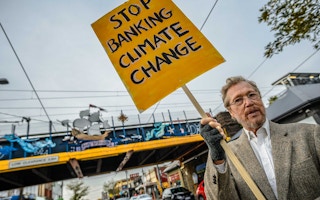The future of the fossil fuel industry grows bleaker every week as even the most conservative business analysts are going cold on coal.
To continue reading, subscribe to Eco‑Business.
There's something for everyone. We offer a range of subscription plans.
- Access our stories and receive our Insights Weekly newsletter with the free EB Member plan.
- Unlock unlimited access to our content and archive with EB Circle.
- Publish your content with EB Premium.
The environmental case against coal has been clear for decades. But the weight of economic opinion opposed to coal is now so heavy, it is staggering that Australia could even consider allowing any new mines, let alone lending money to support one.
But next month, the Australian government may use $1 billion of taxpayers’ money to do just that, as the Northern Australian Infrastructure Fund (NAIF) contemplates a massive loan to Indian industrial giant Adani for its Carmichael coal mine in northern Queensland.
It’s a stupendously backward step to be considering, given the rapid speed at which coal is losing out to renewable energy across the world.
Globally, renewable energy development is accelerating. Even ultra-conservative economic behemoths acknowledge that the trend away from fossil fuels is inexorable. Research released by global bank Morgan Stanley shows that renewable energy is on track to be the cheapest source of power in the world in less than three years.
“Numerous key markets recently reached an inflection point where renewables have become the cheapest form of new power generation,” according to the Morgan Stanley report released this month. The report adds that this is “a dynamic we see spreading to nearly every country we cover by 2020”.
At the same time, coal is on its way out.
According to The Financial Times, in the past two years, developing countries have retired the equivalent of 128 coal-fired generators. US coal production is at its lowest level since 1978. Last month, Britain had its first day of completely coal-free power since the industrial revolution and expects to fully phase out coal power by 2025. Solar and wind energy are already the same price or cheaper than new fossil fuel capacity in more than 30 countries, even without subsidies.
Yet Australian Prime Minister Malcolm Turnbull is determined to believe otherwise, clearly unable to stand up to the right wing of his party, or the powerful influence of the mining industry. Last weekend (July 15), Turnbull claimed that people who say coal and other fossil fuels have no future are “delusional” and they “fly in the face of all of the economic forecasts”. Tell that to the Financial Times and Morgan Stanley.
Despite Mr Turnbull’s opinion, the world is moving rapidly towards renewables.
Elon Musk’s recent announcement that Tesla will build the world’s biggest lithium ion battery plant in South Australia is the latest indication of what our future could be, given more national leadership. The 129-megawatt hour (MWh) project comprises the world’s largest lithium-ion energy storage system ever – more than 60 per cent larger than a 80 MWh facility at Mira Loma in Ontario, California, currently the world’s biggest lithium-ion storage facility.
Dr Kent Moors, an internationally recognized expert in energy policy, risk management and emerging market economic development describes this as ‘a game changer in energy storage that could revolutionize energy worldwide’.
“
As Australia flounders in confusion around energy policy and direction, a year and a half after the UN Paris agreement, the rest of the world is moving forward.
Even Australian states, at the Council of Australian Governments (COAG) Energy Council meeting last week, made it clear they would move ahead with solid renewable energy plans if the Federal Government did not. The Federal Energy Minister Josh Frydenberg stayed on the sidelines threatening the states not to “go their own way.”
Meanwhile energy prices continue to climb around the country, but this is not because of investment in or the failure of renewable energy. It is partly due to a lack leadership ensuring affordable gas supply in the short term, but mostly because there is no clear transition plan to help the market move away from expensive fossil fuel infrastructure to clean energy in the mid- to long-term.
As Australia flounders in confusion around energy policy and direction, a year and a half after the UN Paris agreement, the rest of the world is moving forward.
A new report called Banking on Climate Change: Fossil Fuel Finance Report Card 2017 shows that in 2016, the first year after the agreement, there was an enormous 22 per cent drop in lending to the world’s dirtiest fossil fuel companies globally.
It’s hardly surprising then that in Australia, Adani is struggling desperately to finance its $21 billion dollar mine. In a sign of just how toxic this project is for investors, there are now an unprecedented 23 banks have ruled out financing Adani, including some of the most notable in the world such as Deutsche Bank, Barclays and CitiBank.
Three of Australia’s big four banks, Westpac, NAB and ANZ, have already said ‘no’ to Adani and the Commonwealth Bank is debating whether to join their ranks and why wouldn’t they?
This means the Australian Government’s $1 billion infrastructure loan could make or break whether the project has any financial legs to stand on as Adani goes out to the market to see if anyone will back giant new coal projects post-Paris.
Adani and Australia’s future
Clearly, the Adani project has become a symbol for two divergent visions of Australia’s future.
On one hand is a clean energy future where decentralised renewable energy powers communities, and regional areas have long term new energy jobs. On the other is a continuation of the boom and bust mining model, where we continue to extract and dig up polluting coal and put our faith in the energy sources of the 1800s for our economic prosperity while the market for coal shrinks by the day.
Not only is this model deadly for the planet, but it is also based on the myth that coal is a viable fuel into future. The reality is that resources are finite and if we are to avoid devastating climate change, 80 per cent of our fossil fuel reserves must remain in the ground.
If the Federal Government decides to lend $1 billion from NAIF to Adani next month, it will continue to widen the energy rift between Australia and the rest of the world. The costs to the climate and the country, will be manifold and unpredictable. It just may be the worst $1 billion ever spent.
Blair Palese is chief executive officer, 350.org Australia. This article was written exclusively for Eco-Business.











